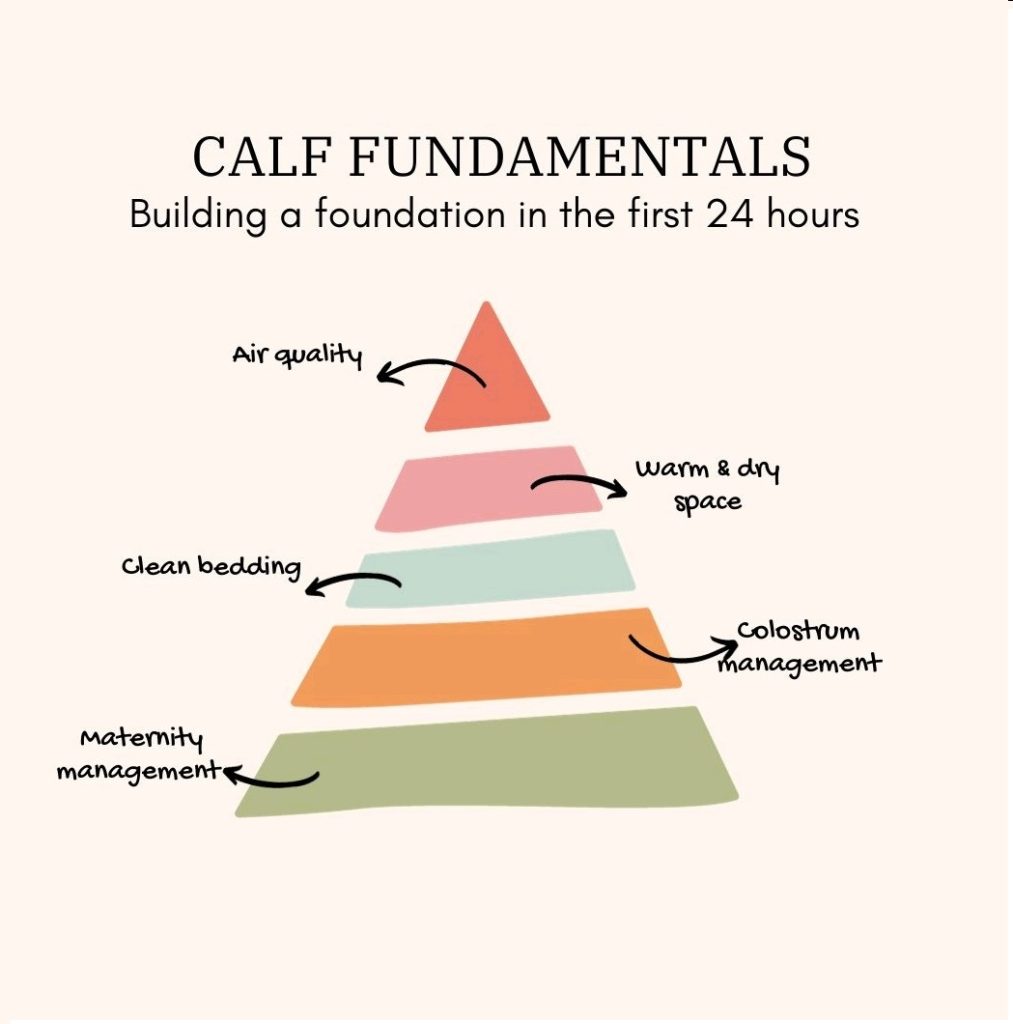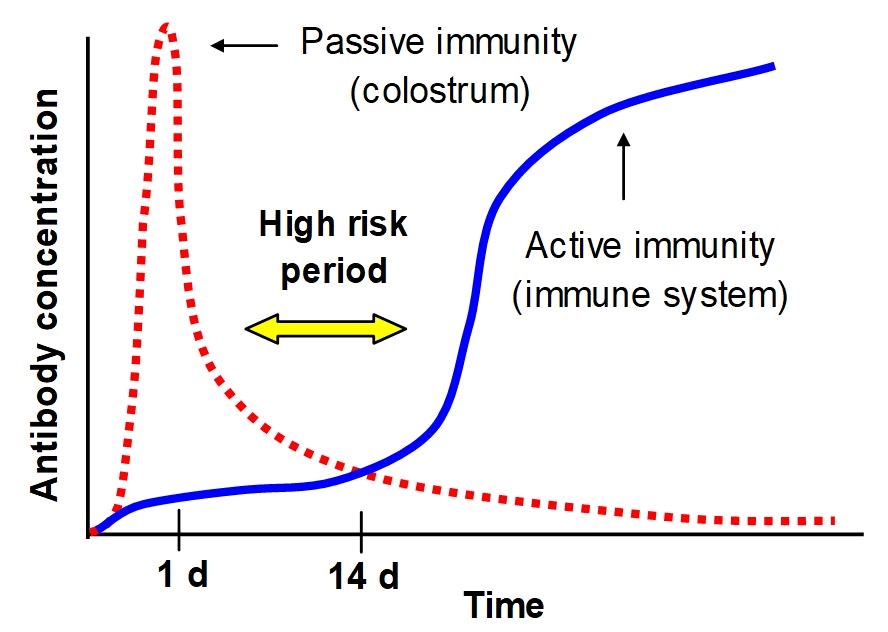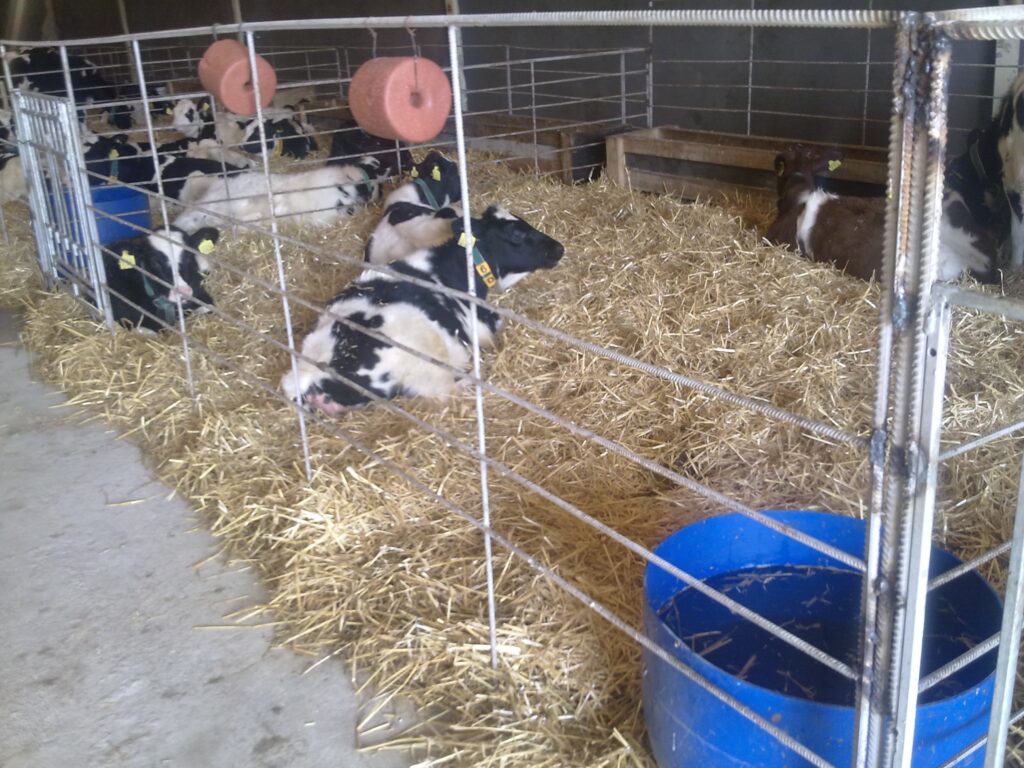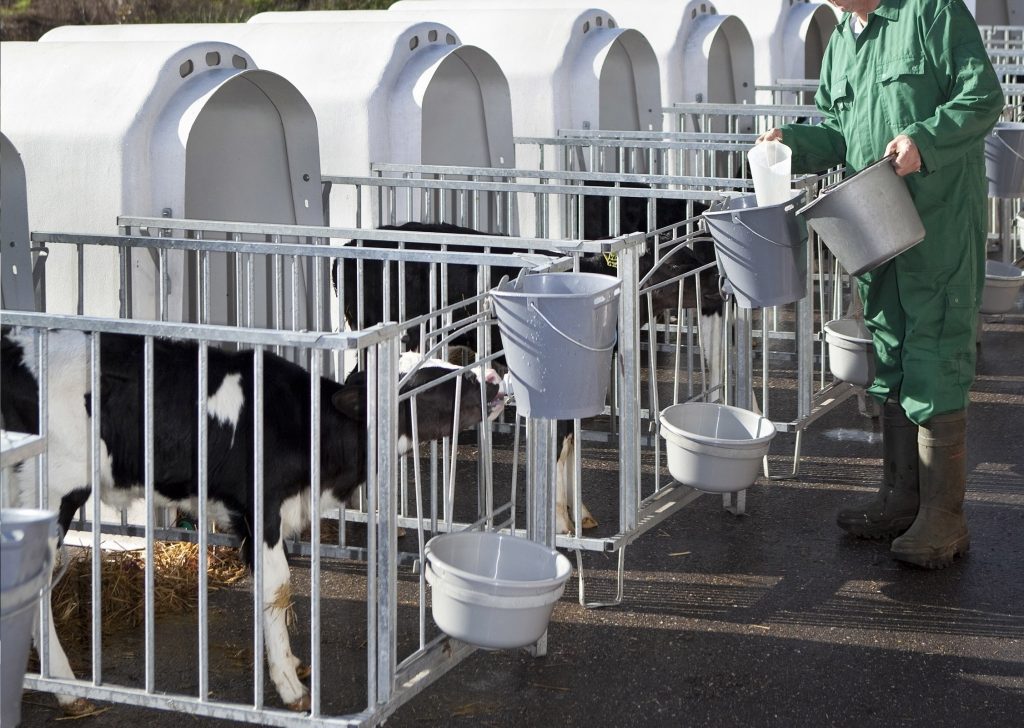
Calf Management
April 29, 2019Calf management in dairy farm
The first 24 hours after a calf is born can have tremendous effects on their overall performance and health throughout their life. Calf management and rearing practices are key components of raising healthy, productive animals. Explore best practices for colostrum management, navel dipping and other essential parts of your calf’s first day of life. 66 % of calves that die in the perinatal period – the time immediately before or immediately after birth – were alive at the start of calving. Essentials for Calf management are:
The calf rearing period covers the time from birth to 12 weeks of age. It includes feeding (colostrum, milk/milk replacer, concentrates, fibre and water), housing, general husbandry and health management of calves from the moment they are born up to four weeks post weaning. Why is the calf rearing period so important?
The First 24 hours
The newly born young animal is unable to produce many of the substances necessary for its body. Newborn calves should be ensured to receive 1-2 liters of colostrum within half an hour after birth. You can drink 4-6 liters of colostrum, which is 8-10% of your body weight, in the first 24 hours.
Follow the colostrum 123 rule: feed all calves the first milk the cow produces (colostrum) within 2 hours of birth and feed at least 3 liters. 3. Colostrum quality decreases as the time from calving to milking for the first time increases; collect as soon and as hygienically as possible.
- Calving management
- Delivery is a high-risk time for both the calf and the cow. Each need special attention, even after a smooth delivery. If there are problems during delivery even more attentive care is needed to help the cow and calf recover. Great calving management sets the dam up for a productive lactation and successful re-breeding, and the calf can start life on the right track.
- Maternity pens
- The maternity area should be in a quiet part of the barn. A maternity pen should be a minimum of 3 m x 3 m (10’x10′), and must be clean, dry, draft-free, and well lighted, insulated and ventilated. This will help with disease control, comfort and footing.
- Navel care
- Bacteria enter a calf’s circulatory system by way of the navel into the liver, and then into the bloodstream.
- Biosecurity
- The calf’s digestive system
- Colostrum

Calf nutritional development First day
Colostrum, which is the first milk that calves should take as soon as they are born (within the first 1 hour), is an extremely complicated secretion that is milked in the udder of the cow that gives birth with the birth. In the first 1 hour from birth and within the first 6 hours, 5% of the animal weight should be given 2 times, approximately 2-2.5 liters each time.

It is not known how much colostrum/milk the suckling baby drinks. Therefore, if possible, feed the calves with colostrum, using a sturdy, functional, 3-liter feeding bottle with handle designed for comfortable use. Bottle use application video
Important management issues and points to be considered while feeding the calf
Calves are born with almost no immunity to diseases and are very hungry. Since calves are exposed to stress as soon as they are born and are vulnerable to disease-causing factors, they urgently need quality colostrum. On the other hand, effective absorption of immune substances (IgG) from the intestine and mixing into the blood can only occur within the first few hours after birth. As time passes after birth, the concentration of IgG in colostrum and its absorption from the calf intestine decrease rapidly, and at the end of the 24th hour, the absorption decreases to 10%.

Colostrum for calf nutrition and development contains 2 solids of dry matter, 3 times of mineral and 5 times of protein compared to normal milk It has vitamins, energy, growth factors, hormones and immune substances (IgG) that help the calf to protect it from diseases. Quality colostrum is the only elixir of wellness for the calf.
Nourish the calves
Providing pre-weaned calves with a rich diet provides many benefits to the animal, the environment, and farm profitability. The first 12 weeks of a calf’s life have a big influence on her health, how quickly and efficiently she can be bred, how much milk she will eventually make, and even influences how many lactations she will have. These factors are the driving characteristics of how profitable this cow will be. To set your calf up for sustainable and profitable lifetime performance, you can focus on these 5 critical control points which effects calf life needs calf management system
- Colostrum: Calves need to receive 3 to 4 liters of high-quality colostrum as soon as after birth possible, preferably within the first hour of life. An additional 2 liters within the first 6 hours and another 1 to 2 liters within the first 12 hours is recommended to fortify the calf’s immune system.
- Calories: Provide calves with a rich diet for optimal immunity, growth, and future performance. Intensive feeding of a highly digestible calf milk replacer for the first 8 weeks of life followed by a stepdown weaning period of 2 to 4 weeks will deliver the plane of nutrition required to optimize performance.
- Consistency: Consistent feeding and cleaning schedules will improve calf performance, health, and welfare. Provide a high quality and consistent source of water, milk replacer, grain, and forage.

Housing Calves
- Cleanliness: Keep the calving area and calf housing area clean and dry. Feeding equipment must be maintained with proper hygiene protocols.
- Cleaning calf housing is one of the best things we can do to keep calves healthy. Considering the fragile nature of a newborn calf’s immune system and that many calf sicknesses are a result of contagious diseases; it is hard to justify skimping on cleaning and disinfection.
- Comfort: Calves should be housed in a dry, bright, and well-ventilated environment with soft bedding. Soft and comfortable calf mats and floors. The best bedding for calves is known as oat straw. In order for calves to maintain their body temperature in cool and cold weather, the material that calves can lie comfortably in is typical straw (Top quality wood shavings, wood chips, and wheat or oat straw are all very good absorbent bedding materials) is recommended. All of them are very good absorbent bedding materials, but the depth of the bedding material is important. In cases where depth cannot be achieved, rubber mats become important.
- Calves housed individually can be easier to monitor than pair or group-housed calves, but individual housing may not reduce the risk of disease transmission among calves. Calves are social animals, so pair or group housing allows them to express normal social behavior and fulfill their need for social contact. Current research recommends housing calves in small, well-managed groups from arrival onto the farm. Pair housing allows for close monitoring of calves while providing social stimulation.
- Ventilation, good air quality leads to healthy animals and a productive animal facility. The goal of ventilation is to provide adequate fresh air that is free from dust and droughts. The air should be reasonably free from pollutants such as ammonia, carbon dioxide and air–borne pathogens. Moisture accumulates and humidity rises when animals are confined without adequate ventilation, so proper air distribution is essential. In totally enclosed buildings, the preferred relative humidity range is 55 – 75 %.
- Group Managing pre-weaned calves in group housing is different than managing young calves in individual pens or hutches. Assessing things like the amount of milk, water or solid feed consumed, or manure passed is much simpler when calves are housed individually, however some auto-feeders do monitor milk intake. Despite this, producers can successfully raise healthy and well-grown calves efficiently in groups from a young age.

Individually or together?
Modern dairy farming systems often choose to separate calves and house them individually during the first few weeks. This offers many advantages, especially in terms of the risk of infection. There must then be room for all born calves up to 3 weeks old in calf igloos. In addition, there must be room for the heifer calves that are being raised to 4 months. This can be done from 3 weeks in group housing. It means that calf igloos must be provided for approximately 15% of the number of cows and group housing for 15% of the number of cows Preference is given to small fixed groups of the same age.
Some points of interest:
- Make sure there is sufficient clean straw in the calving pen. Do not forget to disinfect the navel immediately after the birth of the calf. Take calves as soon as possible to a 100% clean calf igloo (cleaned and disinfected!) For transport, use a specially reserved, clean and disinfected wheelbarrow with clean straw. Then give the animal sufficient good quality colostrum as soon as possible.
- During the first three weeks at least, the calves are to be housed individually in a calf igloo with respect to optimal monitoring of feed intake, building up active immunity, susceptibility to diarrhoea, etc.
- Young calves housed in the same area as older animals are exposed to transmission of disease through the air.
- There must always be a clean, dry surface. Provide litter daily. In the bedding the knees of a lying calf must not be visible.
Weather
Warm weather don’t forget that calves can also experience stress when the temperatures start to rise. When it is over 25 °C, calves may need special attention to keep cool, healthy, and productive. Calves are at their best in environments between 12 – 25 °C. Once it gets warmer than that, they’re eating less and using energy trying to keep cool instead of devoting that energy to growth.
Heat stress
Hot and humid weather can take its toll on people, but calves are also susceptible to heat stress. To ensure calves stay healthy and maintain their growth rates, it’s important to keep them cool and comfortable during the sticky summer months.
Calves suffering from heat stress
Hot and humid weather can take its toll on people, but calves are also susceptible to heat stress. To ensure calves stay healthy and maintain their growth rates, it’s important to keep them cool and comfortable during the sticky summer months. Calves are at their best in environments between 12 – 25 degrees Celsius. Once it gets warmer than that, they’re eating less and using energy trying to keep cool instead of devoting that energy to growth.
Hot and humid weather can take its toll on people, but calves are also susceptible to heat stress. To ensure calves stay healthy and maintain their growth rates, it’s important to keep them cool and comfortable during the sticky summer months.
Calves suffering from heat stress will show signs of reduced movement, decreased feed intake, higher water consumption, rapid respiration, open-mouth breathing and a lack of co-ordination in their movement.
Cold stress
The thermoneutral zone is the temperature range where calves don’t need any additional energy to maintain their body temperature. From birth until four weeks of age, this range is between 10°C and 25°C (50 – 77°F), and from four weeks to weaning, it increases to 0°C to 25°C (32 – 77°F). This means that if temperatures are outside of these ranges, calves need extra nutrition to keep warm and healthy.
When temperatures fall below 15°C, calves less than three weeks will start to use energy to keep warm. Calves older than three weeks start to use energy to keep warm when the temperature is below 5°C. This means if producers do not offer calves more milk (energy), the milk calves are given will be used to keep warm instead of for growing or protecting against disease. Calves not given enough feed in cold weather will not grow and may even go backward and lose weight.
Calf management Tips
Signs your calves might be suffering from cold stress
- They’re shivering, breathing rapidly, or have raised hair.
- Their hooves or muzzles are excessively cold and losing color – the body could be diverting blood from the extremities.
- They’re showing a decrease in body temperature.
Feeding in cold
- When temperatures fall below 15°C, calves less than three weeks will start to use energy to keep warm. Calves older than three weeks start to use energy to keep warm when the temperature is below 5°C.
- This means if producers do not offer calves more milk (energy), the milk calves given will be used to keep warm instead of for growing or protecting against disease. Calves not given enough feed in cold weather will not grow and may even go backward and lose weight.
- Feeding more milk in winter is recommended but increasing milk won’t make up for wet or shallow bedding in the winter conditions.
- A good rule of thumb is to increase the amount of milk replacer by 2% for every degree the temperature falls below 5°C. When the outside temperature is 5°C, 4 liters/day at a concentration of 125g/l is starvation for a calf.
- Introduce changes to a calf’s feeding program gradually and carefully. If you’re feeding more milk, provide it as an extra meal or two instead of increasing the size of the meals you’re already feeding.
- Feed milk at a warm temperature (38.5°C); otherwise, the calf uses its own energy stores to warm the milk to body temperature.
Calf Housing in cold
- Ensure calves have enough bedding to keep them dry and warm. During the fall, winter and spring months, ensure you are bedding with straw, which will help to reduce a calf’s heat loss. Straw should be at least 8 cm (three inches) deep, and dry.
- To determine if a calf has enough straw, do the “kneel test”: kneel on the bedding for 20 seconds and if your knees get wet, change the bedding or add to it.
- Dry off newborn calves and use heat lamps to keep them warm. Wet hair cannot insulate the calf, and as the water evaporates, it takes heat with it and is extremely energy‐costly in young calves. Follow other good winter management practices such as blanketing, providing enough straw for nesting, and making sure calves have free access to warm water.
- Straw is more absorbent than shavings, which helps keep calves dry. A wet calf is a cold calf. Keeping calves warm reduces the incidence of respiratory disease, and straw is the warmest bedding type (compared to alternatives such as shavings, sand, rice hulls, or non-organic options)
- Deep straw bedding allows a calf to nest and trap warm air around their body. When calves are laying down, you shouldn’t be able to see their legs. Usually 3-4 inches (7.6-10 centimeters (cm)) of shavings topped with 12 inches (30 cm) of straw is ideal.
- Add bedding often instead of adding large amounts all at once. This will keep the top layer fluffy (rather than compacted) and dry.
Feeding calves
Sucking behavior of dairy calves
Fed milk ad libitum by bucket or teat: The milk intake and sucking behavior of Dutch and Holstein-Friesian crossbred calves fed milk replacer ad libitum by either the bucket method (n=8) or an artificial teat (n=6) was compared. The animals were observed for 3 weeks from the age of 2 weeks, penned individually and all provided with a “dummy” (artificial) teat near the milk source within the pen.
The teat-fed calves ingested significantly more milk than the bucket-fed calves (11.9 vs. 8.0 kg/day; P<0.05), and this intake took much longer (44.2 vs. 17.7 min/day; P<0.05). In both treatment groups, milk intake was organized in “meals”. The meal criterion, separating the within meal and between-meal non-feeding intervals, was set at 5 min. Frequency of meals and daily total meal duration did not differ significantly. Meals occurred rather randomly throughout a 24-h period.
On average, the dummy teat was used for 13 min per day by bucket-fed calves, but for only 1 min by teat-fed calves (P<0.05). Sucking of dummy teat was largely clustered within the meal periods.
It is concluded that in the young calf a need for sucking exists independently of milk satiation. However, the level of satiation depends on whether the calf drinks or sucks the milk. Nutritive sucking is clearly more reinforcing than non-nutritive sucking. https://www.sciencedirect.com
The calf’s digestive system
- Water is the most essential and cheapest ingredient in any livestock feeding operation. A 180–kg calf will require 10–30 liters of water daily, depending on factors like temperature, humidity and the dry matter content of the diet. To achieve maximum gains, provide an adequate supply of clean, easily accessible water. Test the water offered to calves and mixed with milk replacers as the pH, mineral content and bacterial counts are of primary concern. It may be necessary to install water treatment equipment to ensure good water quality for your animals.
- Feeding calves milk through a teat instead of an open bucket provides advantages for their digestive physiology, health, productivity, and welfare. Allowing bucket-fed calves to suck from dry a teat after feeding provides some of these advantages
- Milk feeding
- Automatic feeders
- Solid feeding
- Cold weather feeding
- Hot Weather Feeding
- Weaning or transitioning a calf from a milk-based to a solid feed diet, is most stressful times in a calf’s life. Implementing management strategies such as gradual weaning, group housing, and providing access to starter and water is essential for improving the overall health, welfare and economical potential of the calves. Find helpful advice for making this transition easier for your calves here for better calf management.
Health and welfare
- Calf-hood diseases
- Pneumonia
- Scours
- Dehydration
- Treatment and prevention
- Medications
- Why are calves so vulnerable to illness?
- Early disease detection
- Cleaning
- Biosecurity
- Euthanasia
- Disbudding and dehorning
- Important tips to improve calf comfort during castration
- Veterinariation
